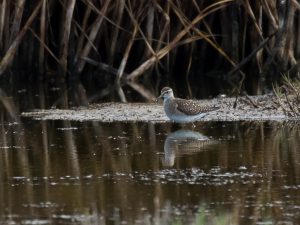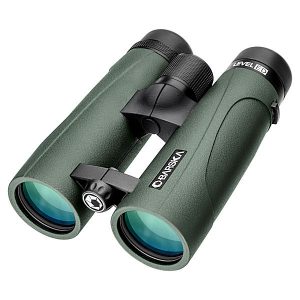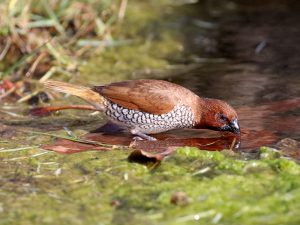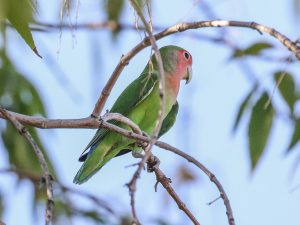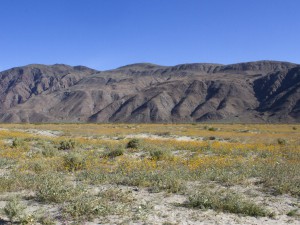Recently, a report of a Wood Sandpiper (Tringa glareola) up in southern Humboldt County, California, sent our pulse jumping. The Wood Sandpiper is a Eurasian shorebird, related to our Solitary Sandpiper. There are comparatively few records of this bird for North America. Wood Sandpipers stray as far as New York occasionally, though most records come from Alaska. This bird is rare enough that some North American field guides don’t even illustrate it. When the photos came through, confirming the bird, we put together a whirlwind trip to go see it. It was a 12-hour drive to the Russ Ranch Wetlands where the bird was, so we set off the night before and drove through the night to reach the marsh the next morning. Continue reading
Barska Level ED Open Bridge
Goodbye Eagle Optics Rangers. Hello Barska Level ED
One of the most popular low-cost binocular series in the history of Optics4Birding has been the Eagle Optics Rangers. The Ranger went through several incarnations and improved each time. So, when Eagle Optics closed, we were disappointed to lose the Rangers, and we started looking for a good replacement. In January 2018, we found the Barska Level ED Open Bridge binoculars. Even without a head-to-head comparison, we knew had found our replacement. So, we arranged an evaluation piece from Barska to try them out. Read on to find out why we feel so strongly about the Barska Level ED binoculars. Continue reading
Bishops and Munias and Whydahs! Oh My!
Few subjects provoke the ire in a roomful of birders more rapidly than whether or not to count introduced species. The ins and outs of what is “countable”, what is “established”, and what is still an exotic alien has reddened faces and clenched fists among birders for decades. After that comes the discussion of which state bird records committee is loosest or tightest in their approach to exotics. By then, former friends begin to disperse faster than the young of the year.
But in the end, that is not really what matters here. When it comes to counting exotics, I find myself more and more adopting an eBird stance. That is: count them all, do it as accurately as possible, and submit your data. In the end, the importance of this goes far beyond a mere life list. What matters most is the impact that these growing populations of exotics have upon our native species and the environment in general. Make no mistake about it, that impact is huge. Continue reading
Exotic Parrots in North America
Any discussion of introduced bird species in North America would be incomplete without considering exotic parrots. In fact, parrots and their allies constitute the single largest class of exotic birds on the continent. According to Forshaw’s Parrots of the World, there are/were 356 parrot species extant in the world as of 2010. Over 20 psittacids (parrots and their relatives) occur frequently enough in North America that the major field guides illustrate them. Yet only eight species grace the official North American checklist. Of these, arguably only six became established anywhere. Those six are: Monk Parakeet, Nanday Parakeet, Green Parakeet, White-winged Parakeet, Red-crowned Amazon and Rosy-faced Lovebird. See the table of species and their status below.
The irony of it abounds. Historically, North America only ever boasted two native psittacid species: Carolina Parakeet and Thick-billed Parrot. The Carolina Parakeet is famously extinct. Thick-billed Parrot was extirpated from its tiny historical range in the United States decades ago. Moreover, they are endangered in their restricted Mexican range. All efforts to re-introduce Thick-billed Parrots in the southwest met with failure. So any parrot seen in North America is by definition, an exotic. Perhaps many species not on the official checklist are well on the way to becoming established. Continue reading
The Death of Planet Earth
Has mankind really driven the planet to the edge of a catastrophic crash of life? Is greed blinding us to what is right in front of our faces? Some would say maybe these claims are a little too reactionary. Okay, so a bit of Florida gets wet, and maybe some people will have to move inland. Can’t science just come up with new technologies to solve the dilemmas we face? Does industry just need to develop a practical and economical electric car? What would happen if we just did “business as usual”? The claims of doom are a bit extreme and, if we accept them at face value, they are really inconvenient to living our lives. What is science telling us about what is happening right now, what we face in the very near future, and what can be done to avoid it?
Earth really is exceptional. From our naturalist point of view, this planet’s life is unimaginably beautiful and breath-takingly diverse. But it doesn’t take a genius to see that Earth’s abundance and diversity is disappearing. There is a point at which this decline becomes mass extinction, and that point is much closer than you may think. Our own survival is indeed inextricably tied to the health of our world. If we expect science to save us, then we need to listen to what science is telling us. Continue reading
Solar Eclipse in Irvine, CA
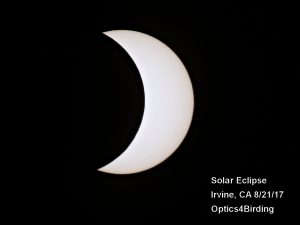 Today the buzz is the solar eclipse. Although here in Southern California we did not get the full solar eclipse, it was still a pleasure to see the partial occlusion. Of course, having a store full of spotting scopes and a solar filter for a spotting scope we snuck out briefly from our work to take a couple quick photos at the peak of the event, out in the parking lot.
Today the buzz is the solar eclipse. Although here in Southern California we did not get the full solar eclipse, it was still a pleasure to see the partial occlusion. Of course, having a store full of spotting scopes and a solar filter for a spotting scope we snuck out briefly from our work to take a couple quick photos at the peak of the event, out in the parking lot.
The Optics4Birding store is located about 45 miles south of downtown Los Angeles. The peak of the eclipse happened at about 10:20 AM. It really was quite interesting. Although without filters to look through you would never know it was happening. The sun is so bright that from our vantage point and even with about 60% of the sun being eclipsed, with the naked eye you didn’t notice any difference. Contrary to this, wearing solar filter glasses it was quite interesting. Looking at this through a spotting scope was really interesting.
Digiscoping the solar eclipse
We took photos with both the Swarovski ATX using a 95mm objective module and the Kowa TSN 884 spotting scopes. We used a Canon 7D mark II DSLR camera on the Swarovski ATX spotting scope and the TLS APO 30mm attachment.
On the Kowa 88mm TSN 884 we used a Panasonic Lumix G-6 Micro 4/3 camera with an Olympus 14-42 zoom lens. We attached this using the Kowa TSN-DA10 digiscoping adapter. Both setups are very simple to take pictures with. Normally we would be taking nature photos. Of course, this was a natural event! Typically, though, most of us are photographing birds or animals with our spotting scopes.
It did make for a fun morning and a nice break from work. The weather cooperated and we had nice clear skies. Certainly, many people will have gone out to see this today. Having the right stuff to enjoy these type of events is always a pleasure.
Eureka – A Snowy Plover Story
The amazing story of Eureka, the Western Snowy Plover, began with an unexpected event on Memorial Day weekend of 2017. I do quarterly surveys for Western Snowy Plover (Charadrius nivosus nivosus), an endangered species along the west coast of North America. We survey a 2.2-mile stretch of Huntington State Beach in Orange County, CA. With my teammates, Doug and Chuck, we’ve surveyed this beach every January, March, May and September for four years. Huntington State Beach is a crucial roosting and feeding area for Western Snowy Plover, and we see some on every January, March or September survey.
Surveying takes three of us because the beach is quite deep at about 500 feet from the parking lot to the water’s edge. Our team walks in parallel, zig-zagging down the beach to cover everything. Snowy Plovers, with their pale, wet-sand plumage, can be hard to spot. They make it harder by crouching down in little divots on the beach, hiding until danger is right on top of them. May is the boring survey because it’s the only time we don?t see the plovers on our beach. By May, the plovers have migrated to their breeding areas elsewhere. Continue reading
Anza-Borrego Super-Bloom
Just when you think you understand things a little, along comes an event that puts you in your place! The rainfall here on the west coast of the United States in 2017 has been a bit odd. Very welcome, to be sure, but a bit odd. We greatly exceeded expected rainfall this winter and spring. From Washington down to northern California, experts declared an official end to a drought that lasted about a decade. This refilled reservoirs and lakes in that region to capacity.
In southern California, the rain didn’t erase that long drought as completely, but it still had staggering effects locally. One factor that makes the rain so odd is that it occurred completely outside the Pacific oscillation cycle. The El Nino and La Nina events govern these oscillations. These rains at Anza-Borrego State Park produced a huge wildflower super-bloom. That greatly benefited White-lined Sphinx moths and their predators. Continue reading
Chiapas Owls
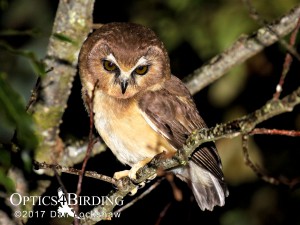
The highly sought after Unspotted Saw-whet Owl inhabits the cloud forest mostly above 8,000 feet in elevation. In this photo, light dew is visible on the owls head from the mist in the forest. In this photo, light dew is visible on the owls head from the mist in the forest.
After 15 years, I finally got brave enough to go back in search of the Chiapas owls. Chiapas is the southernmost state of Mexico that borders Guatemala. This was pretty much a mandatory destination to complete our sister owling.com website. There is no other state in Mexico with as many owl species as Chiapas. This area is also crucial to our current understanding of owl taxonomy. New divisions and more accurate classification of the owls are slowly becoming known and being clarified by science.
Chiapas is spectacular for wildlife and has an extraordinary history, but suffers from terrible pollution and horrific habitat destruction. While the natural wealth is immense, the population is poor, and traveling there can be dangerous. Having done this before, my plan was to mitigate risk, so I invited a friend and hired a guide. We documented nine species of owls in nine nights (video, recording, photograph, etc.) along with over a hundred eighty species of birds and mammals in the daytime. I will cover more of this in an upcoming article. Continue reading
A Laysan Albatross in Orange County
The Sea and Sage Audubon chapter winter pelagic trip ran recently on a February day following strong winds and storms from the southwest. A fairly large swell kept people on their toes for most of the day (going airborne while on a boat is bad!!). It was by turns rainy, windy, drizzly and sunny. For those who braved the weather, however, the returns from this trip were spectacular! Every pelagic trip begins with a sense of hope: maybe you’ll see something rare, like an albatross. But realistically, you never really expect one to show up. As it turned out, they weren’t long in coming, and in this case it was an unprecedented one.
Laysan Albatross
The boat left Dana Point harbor and headed straight out into the California Channel. Four miles out, a call of “Albatross!” went up from the back of the boat. The usual stampede ensued! The bird in question, a spectacular adult Laysan Albatross, Phoebastria immutabilis, provided a first record for Orange County. This particular individual was a handsome adult bird. The distinctive dark wings and all-white body, nape and crown are distinctive. And the grayish shadow to the auricular and large pinkish bill with a pale bluish tip seal the deal. The bird made several passes by the boat, found nothing that interested it, and sailed off, leaving us all wishing for more. Alas, it was not to be as we never saw this bird again during the entire trip. But it sure woke everyone up! Continue reading

